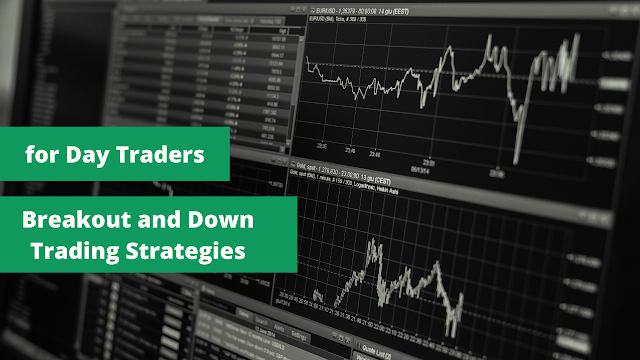Breakout and down trading strategies are simple yet effective trading strategies used by active traders during the day. They are used to capture quick profits in short-term price fluctuations and can be applied to many different markets, including stocks, futures, options, forex, and cryptocurrencies. Before you dive into breakout and down trading strategies, however, it’s important to understand the basic principles of technical analysis and how they can be applied to trading in any market.
What Are Breakouts?
When a currency moves outside the confines of an identified price level and trade increases for that currency, this is called a breakout. In this type of trade, you take a long position (the belief that the price will go up) if the stock price moves higher after meeting resistance or takes a short position (the belief that the price will go down) if the stock price moves lower after meeting support.
There are several different types of breakout trading strategies, but one of the most popular is the channel breakout trading strategy. This strategy looks for stocks that are trading in a well-defined range (support and resistance levels) and then enters a trade when the stock price breaks out of that range.
Another popular breakout strategy is the opening range breakout. This strategy uses the first few minutes of trading to identify the day's high and low, and then enters a trade when the stock price breaks out of that range. The range breakout strategy is similar to the opening range breakout except it focuses on entering a trade at the end of the trading session when stocks have settled down and volatility has decreased. The range breakout strategy identifies stocks that have experienced volatile trading action and buy them if they close near their highs for the day. On the other hand, if the stock closes near its lows for the day, it sells those positions instead.
The Best Tools to Identify a Good Breakout Candlestick Pattern
If you're a day trader, then you know that timing is everything. That's why it's important to have a good breakout trading strategy. There are many different ways to trade breakouts, but one of the most popular is the channel breakout trading strategy. This strategy looks for a candlestick pattern that has formed outside of a defined channel. When this happens, it signals that the market is about to make a move. You can use the information to time your entry points. It also helps identify whether or not a stock is going up or down in value. You can set your risk level based on where you enter into the position. Channel breakout trading strategies typically carry less risk than range breakout strategies because there are limits as to how far in either direction prices can go before they hit the opposite boundary. The main benefit of this strategy is being able to take profits quickly while risking less capital, which makes it an attractive option for beginners who are still learning their way around the technical analysis and want more certainty in their trades. But if you are looking for a strategy with high rewards and higher risks, range breakout strategies might be what you need. Range breakout trading strategies allow you to catch larger swings in the price of stocks by targeting specific levels of support and resistance. For example, when a company hits new highs (or lows) in its share price over consecutive days, traders might decide to buy (or sell) stocks near those levels with the assumption that prices will continue to rise (or fall). One advantage of range breakout trading is that traders don't need very accurate predictions because all they have to do is predict how far prices will go before reversing course within each rally or sell-off.
Example of Catching a Broken Out Trend in Review
One of the most popular breakout strategies is the channel breakout trading strategy. This strategy can be used on any time frame from 5 minutes up to weekly charts. The key to this strategy is to identify a price channel that has formed on the chart. A price channel is simply a range that prices have been trading in for some time. Once you have identified a potential price channel, you can then watch for a breakout from that channel.
The day trading breakout strategy is a little different from the traditional breakout strategy. When using the opening range breakout strategy, traders will look for two or more consecutive candles with an opening range between two predetermined values. If these conditions are met, then traders will enter a long position when the market opens if the opening range is above one predetermined value or enters a short position if it's below another predetermined value. There are other types of range breakouts such as daily range breakouts, hourly range breakouts, and intra-day range breakouts. These types work the same way as the opening range breakout strategy but with only one set of predetermined values instead of two. It can also help to use Fibonacci retracement levels. For example, if we are looking at an hourly range breakout strategy we would use Fibonacci retracement levels of 38%, 50%, and 61%. We would draw these lines on our chart by going down 100% percent from our top trend line (or previous high) and going up 100% percent from our bottom trend line (or previous low). So let's say the last high was at $100.00 and the last low was at $40.00; those would be our top trend line (or previous high) at $100.00 and our bottom trend line (or previous low) at $40.00.
How to Tell If a Stock Is Heading into a Spike or Breaking Down
If you're day trading, you need to know how to tell if a stock is about to spike or break down. This knowledge will help you choose the right strategy-whether it's a channel breakout trading strategy or a range breakout strategy-and make the most of the opportunity. Here are four things to look for: - Is the chart in an uptrend? If so, you'll want to use an opening range breakout strategy as your entry point. - Are there any bullish patterns on the chart? Bullish patterns could be a small price consolidation (pennant) pattern that turns into a flag pattern or an inverted head and shoulders pattern (bullish). The idea is that these bullish patterns create momentum in your favor so take advantage of them by using either a range breakout strategy with tight stops or enter on breaking out at the pennant peak. - Are we in volatile market conditions? When markets are volatile, it becomes more difficult to gauge which direction stocks will go so use channels as your trading range instead of trying to trade too aggressively and risking large losses. A good example would be to buy near the upper range of a channel when prices have been gradually moving up over time but have suddenly pulled back to test support. Channel breakout trading strategies involve buying near the upper range and then selling when prices retest resistance or selling near the lower range when prices pull back to test support again. You can also wait for a range breakout before entering a position. Range breakout strategies involve waiting for prices to move from one side of the range boundary to another before buying or selling based on whether prices are trending higher or lower. Be sure not to wait too long because some range breakouts can last hours, days, weeks, or even months. As long as prices continue moving in one direction-upward or downward-the strategy remains valid until they change course and move against you. For successful trading, just remember this advice: You don't win if you don't play.
Using Stochastic, MACD, Relative Strength Index, Moving Average Convergence Divergence (MACD) to Find Overbought/Oversold Levels for Stocks
When a stock price breaks out above the upper Bollinger Band, it is considered overbought, and when it breaks out below the lower Bollinger Band, it is considered oversold. A channel breakout trading strategy can be used to trade these breakouts. To find stocks that are ripe for a breakout, look for those that are trading in a range with tight Bollinger Bands. MACD is another indicator that can be used to find overbought/oversold levels for stocks. Channel breakout trading strategies typically use an opening range breakout, while range breakout strategies typically use a range breakout. Opening range breakouts occur when the opening of a period trades outside of the first range (tightest) range. A trader would enter a position on the first bar that trades outside of this range. Range breakouts occur when prices close outside of the first range (tightest) range. These strategies also involve taking positions on any one bar that closes outside of this range as well as waiting for multiple bars to close outside of this range before entering positions. For day traders who have trouble staying awake late into the night or during the early morning hours, using range breakouts is advantageous because they are less sensitive to time. For example, if your target entry point is between 2:00am-5:00am EST, you could use ranges from 2:00pm-4:30pm EST to calculate potential entry points. Finally, channel breakout trading strategies often will trade two pairs at once since both channels overlap each other in most cases; this creates a higher probability of finding winners by including both options at once. The long leg of the range breakout strategy involves buying after breaking through the resistance level and selling after breaking through the support level. The short leg of the range breakout strategy involves selling after breaking through resistance and buying after breaking through support.
Looking at the Bigger Picture When Identifying Trends
When you're day trading, it's important to not get caught up in the small movements of the market. Instead, you should be looking at the bigger picture to identify overall trends. For example, a range breakout strategy looks for a sustained move outside of an established trading range. An opening range breakout strategy identifies potential breakouts at the start of the trading day. And a channel breakout trading strategy looks for breakouts from price patterns that form channels. A range breakout strategy has been helpful when a stock is moving within a tight channel (not much volatility). Opening range breakouts have been helpful when prices have remained relatively stagnant for hours or days with no major movement. A channel breakout trading strategy can also work well with stocks moving within tight channels where there is little volatility in either direction. To understand how this works, imagine two traders each holding 1,000 shares of Company X. One trader sees the channel breakout trade strategy and buys on both sides of the channel support level because he believes the trend will continue and wants to maximize his profits if that happens. The other trader doesn't want to buy until she sees a strong signal because she thinks that trend may change any minute now so she would only buy if her initial assumption was proven correct. With a channel breakout trading strategy, one successful trade could double your money. Of course, your risk is double as well since your stop loss could be significantly wider than usual due to increased volatility in the event of big price swings.


0 Comments